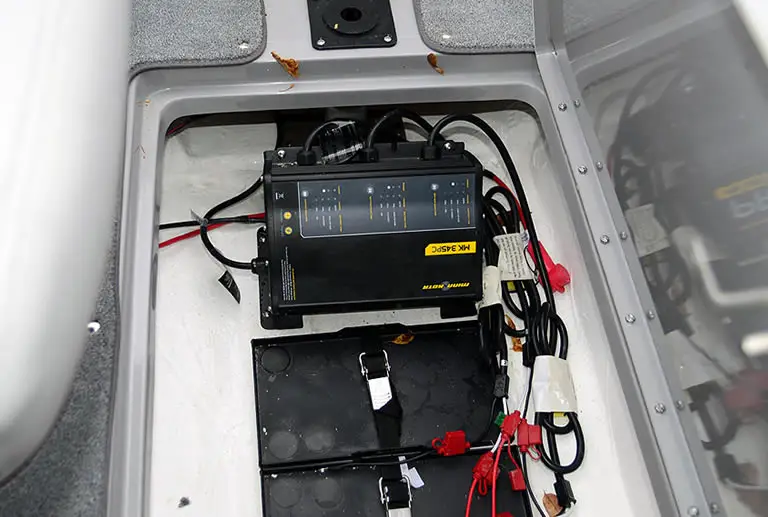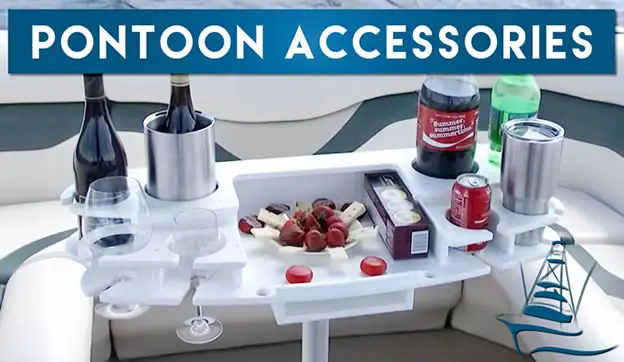All motor operated vehicles require a battery and that battery needs charged. We all know that alternators in road vehicles are responsible for charging automotive batteries but how does a boat battery get charged?
A boat charges its battery via an alternator, or similar charging system, that is located on the boat. As the motor runs it sends a charge, via the alternator or similar device, to the battery.
As boats are usually docked, or stored, during the winter months, and not used on the water, the battery on the boat may require a charge before use when you de-winterize the boat.
Boat batteries and alternators should be maintained following a simple procedure.
Contents
How boat batteries get charged on the water
A pontoon boat battery is similar to other marine batteries on other boats. It is responsible for helping the starting motor turn-over the engine to start it.
A boat battery is just as important as a car battery and works in a very similar way.
A boat battery usually requires the same type of attention as a battery in a road vehicle. This, for the most part, means it needs very little attention. As long as your engine, alternator and battery systems are working correctly and are at optimal levels your boat battery should not need your attention at all.
Essentially if the electrical and mechanical systems on your boat are running well the the boat motor charges the battery through the alternator.
Though giving the entire electrical system on a boat a check-up once or twice per year is a good idea.
A boat has an alternator that charges the battery
Most boats are fitted with an alternator which is responsible for charging the battery.
The alternator takes energy from the running motor and uses it to recharge the battery.
How the alternator works to charge the battery
Many people mistakenly believe that the battery on their vehicle, whether that be car, truck, airplane or boat, is responsible for running the electrics. This is not how it works. The battery on your pontoon boat, and other vehicles, is solely responsible for starting the motor.
Once the pontoon boat outboard motor is running it is the alternator that is responsible for sending electrical current to the electrics on the boat. It also sends a charge to the battery to replace the energy that was taken from it to start the motor.
The alternator is a type of mini generator. As the motor generates power it operates a pulley system which is connected to a rotar shaft and a belt drive system on the alternator. This system creates the electrical charge necessary to run the boat and charge the battery.
The alternator has an inbuilt regulator that controls how much electrical charge is sent to the battery to avoid too much current frying the battery.
The rectifier in the alternator is used to convert the AC current that is being generated in to a DC current for use.
The rotor inside the alternator is spun by the pulley and belt drive system to act much like a small spinning electromagnet.
Slip rings are used in the alternator as a means of providing the necessary direct current to the rotor. While the slip ring end bearings support the spinning of the rotor shaft.
The stator is a stationary piece thin metal that is coiled and that sits outside the rotor. This is responsible for creating the electrical current when the magnetic field is created by the rotor.
The drive end bearings are designed to support the rotation of the rotor shaft.
The pulley is connected to the rotor shaft and the belt drive system. The spin that is created by the motor is what powers the belt drive system which turns the pulley and thus begins the battery charging.
You should check the battery for charge level
Checking your battery charge level every now and then will help you to quickly identify any possible charging difficulties before they become more serious problems.
All you need is a simple battery tester.
Do not get fooled into thinking you need to pay a large amount of money for a marine battery tester that costs several hundred dollars. I give an example below of a high quality battery tester you can pick up for less than $50.
Boat battery charging problems & their causes
If a battery is not charging the cause could be a minor issue, that is easily fixed, or a more serious problem, that will cost money to fix.
The first thing to do is check the battery itself before moving on to the alternator.
Bad connections
Check the terminal posts where, the connectors are attached, for corrosion. Sulfate build-up can stop the current from passing from, and to, your battery.
In the battery care guide below I give you a few tips for cleaning the terminal posts and protecting them from future corrosion.
If the battery seems to be in good working order and there is no obvious damage, or bad corrosion on the posts, then it is most likely your alternator that is at fault.
Lose alternator belt
The belt on the alternator is responsible for spinning the rotar. If it is lose it will lead to a loss of power. There will not be enough power generated and sent to the battery to charge it. As starting the motor will require more electrical charge from the battery than the alternator is providing to the battery to recharge it, eventually the battery will go dead.
If the belt is not lose then you will have to get a mechanic to check your alternator is working.
Do not test your alternator by starting the motor and then disconnecting the cable from the battery.
Back when every mechanical piece on a boat was purely mechanical this test worked fine but these days almost everything has a computer chip in it.
When you disconnect the battery it is likely that the regulator, in the alternator, will force the alternator to pump out maximum power which can fry the electrics all across the entire boat leading to thousands of dollars in repair costs!
How to charge a boat battery
Always use a smart charger to restore a full charge to your boat battery.
A marine battery charger will help to dissolve sulfate build-up as well as charging your battery.
This not only helps prolong the life of the battery but it makes it perform better and helps it to hold its charge for longer periods when the boat is not in use.
How long it takes to charge a boat battery
If everything is working correctly on you boat then the motor will charge a boat battery via the alternator. This is an ongoing process that is imperceptible to the boat operator.
If you need to use a marine battery charger then it will usually take between 4 – 6 hours to charge the boat battery depending on the state of its depletion.
Boat battery and alternator care
Taking care of your pontoon boat’s battery and alternator involves only a few simple and quick maintenance steps.
Below are guides to maintaining your battery and your alternator.
Boat battery care guide
Start by cleaning any obvious dirt or grime that has accumulated on the battery casing. Then turn your attention to the terminal connectors and posts on the battery.
- Make sure the battery terminals/posts are corrosion-free as corrosive build-up will interfere with the electrical currents going to and from your battery. If there are signs of corrosion try to clean-up the posts with a wire brush and then use a marine dialectic grease
) to protect them from future build-ups.
- Ensure the electrolyte levels on the battery are at optimal levels. If your pontoon boat battery is marked with a maximum line, be sure there is enough distilled water in it so it reaches that line (though not above it). If your battery does not show a maximum line, fill it to about 1/8 below the ring of plastic which extends into the cell, being sure not to overfill it.
- Make sure your battery has a full charge. Use a battery tester to check this. You don’t need to break the bank on a battery tester. There are marine and car tester models that can be as expensive as $200. However, you only need a cheap battery tester like this one that works on 6, 12, and 24 volt batteries
which you can pick up for less than 50 bucks! 12 volt batteries such be charged to 12.9 volts, while 24 volt batteries can be charged up to 28.3 volts.
- If your battery needs charged then, for best performance, use a high quality smart charger
to help dissolve sulfates that inhibit charging, as this will allow the battery to receive a full charge and better retain that full capacity.
Boat alternator care guide
Alternators are fairly easy to maintain.
Although most boat owners never go near their alternator a little care taken once or twice per year will protect your alternator, your battery and your boat.
- If you have an air cooled alternator check its vents for any obstructions that may be there. If the alternator also has an external fan fitted check that it is in good working order and the blades are dirt-free.
- If you have a liquid or oil cooled alternator you will have to do a little more maintenance work. Be sure the liquid or oil coolant levels are at the correct levels and only top-up the levels with the manufacturer’s recommended products. Also check the coolant lines for any newly developed bends or kinks. Ensure the vent, or drain, lines remain clean and clear.
- Check the electrical connections are free from dirt and grime. Just as dirty or corroded connections impede a battery’s ability to discharge electrical current and receive a charge, dirty connections on the alternator greatly impeded its ability to generate and distribute power. Clean them in the same way you would clean the battery connections.
Follow the above maintenance advice and you will be able enjoy your pontoon boat for a long time to come without any problems.
You may also be interested in reading our article on the 55 best pontoon boat accessories especially if you want to have a pontoon boat party or use your vessel for other fun activities.



